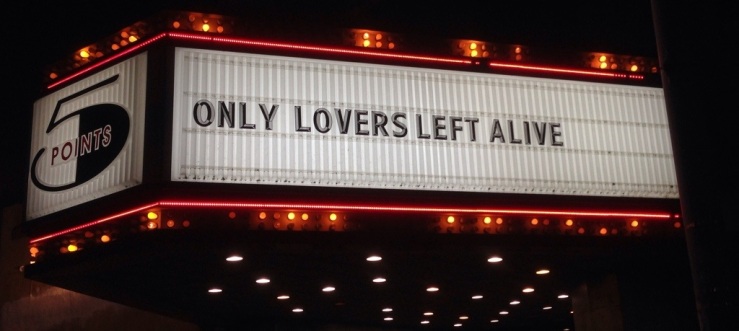
Jim Jarmusch’s latest film Only Lovers Left Alive is excellent.
Moody, sometimes funny, always gorgeous, and largely plotless, the film centers on two vampires—Adam and Eve, played by Tom Hiddleston and Tilda Swinton—who fill their long lives with music, literature, and love. At its core, the film is an elegiac love song to aesthetic originary creation in the age of the curator.
As Mike D’Angelo points out in his smart review,
What really interests Jarmusch is immortality, or at least longevity. How would we behave if we lived for centuries, and were free to do pretty much anything we wanted? What sort of aesthetes and collectors might we become? … In this world, the vampire’s primary function is to appreciate the things we humans take for granted; they’re much more like curators than monsters.
Eve’s curatorial powers are enviable—she merely has to touch an object to know its age (and quality). She touches Adam’s beloved Gibson guitar, declaring “1905.” As she packs her suitcase full of books (Don Quixote, Infinite Jest, and Kafka all make the cut), she scrolls her fingers through pages briskly but lovingly, seeming to absorb each one instantly.
Adam’s curatorial impulses manifest in his collection of antique musical and electronic equipment, his claustrophobic crumbling mansion a mad scientist’s lab of sight and sound. Adam creates plodding dirges, death songs, elegies for the end of romance. Reclusive cult hero, he hides in the outskirts of Detroit from his growing fanbase who demand to know who made this music. Like Wyatt, the masterful forger of William Gaddis’s novel The Recognitions, Adam wonders what people want from the person that they couldn’t get from the work of art. Still, as he mournfully complains to Eve, Adam wants a reflection, something to echo back to him. His fans—the “zombies”—are not enough.
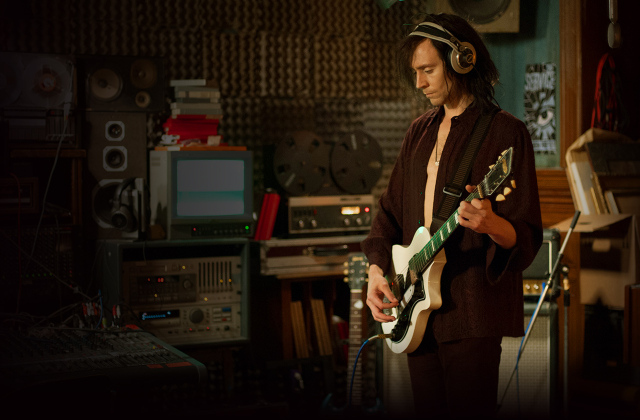
Eve’s library and Adam’s studio allow Jarmusch to perform his own curatorial impulses. On one wall in a room of Adam’s mansion hang the portraits of dozens of writers and musicians, including Blake, Poe, Twain, and Christopher Marlowe. Marlowe it turns out is a vampire—and the real author of Shakespeare to boot.
It might be tempting to accuse Jarmusch of merely providing fan service for hipsters, but there’s more going on here than simple name-checking. Adam’s wall isn’t simply a shrine for hero-worship. Instead, it feels like a gallery of family portraits.
Some viewers may find Adam and Eve’s aesthetic obsessions insufferable. As if in anticipation of this criticism—and as a sort of counter argument—Jarmusch plants an internal critique of his lovers in the film in the form of Eve’s kid sis Ava, an impulsive, strangely immature, and ultimately tacky vampire. In her acrimonious parting with Adam and Eve, Ava curses the pair as “condescending snobs.” She is, of course, absolutely correct.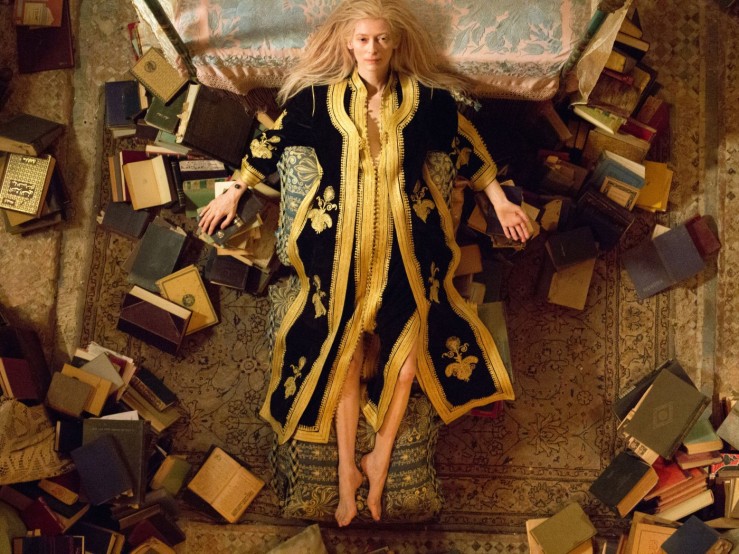
Adam and Eve are snobs, but perhaps living through eons will do that to a body, so what should we expect? Adam, black-haired, always dressed in black, veers along a desperate, suicidal spectrum, writing dirges for the end of the world. Eve, golden-haired, clothed in white, must constantly remind Adam of eternal recurrence, a motif figured in Jarmusch’s repeated shots of spinning 45rpm records. Adam mourns the death of Detroit, but Eve tells him that it will bloom again when the “cities of the South are burning.”
Only Lovers Left Alive is peppered with these notes of apocalypse, but Eve tempers them with a kind of weary optimism: She and her lover will survive, and they will preserve what is worth preserving, worth loving. Not only will they curate, they will also create. As the film rushes to its ending in Tangier (my biggest criticism is that we could use another half hour)—oh, and that word “ending”: yeah, look out, fair warning, some spoilers ahead—as the film rushes to its ending, Adam and Eve experience intense blood withdrawal.
Their hunger is both literal and figurative. These vampires are empty, out of blood, but also seemingly out of inspiration. Adam has been forced to abandon his collection of instruments, and with them, perhaps, the new music he had sought to create. In a fantastic final sequence, Eve takes Adam to see a strange and stunning performance in an open cafe—a singer who carries a wistful song over the dissonant strains of electric guitar. The music is simultaneously ancient and original, and we see that it nourishes Adam’s muse anew. Creation arises from curation, from the synthesis of preexisting elements.
But art is not enough. Our demigods require blood. It’s only in the final moments of Only Lovers Left Alive that Jarmusch’s vampires fully act on their predatory nature. The two, starving, advance on a youthful man and woman—a boy and girl, really, who are so deeply entangled in passionate kissing that they are oblivious of their leering spectators. Knowing that they must eat or die, Adam and Eve agree to consume the young lovers. Crucially though, in the final lines of the film, our vampires clarify—to each other, of course, but also the audience—that they are not going to kill the young couple, but rather turn them into vampires. They are going to create.
Jarmusch suspends the horror of the cost of that creation, distilling it into one terrifying final image. The shot is brief but powerful, and if it doesn’t exactly counterbalance the previous two hours of gloomy aesthetic pleasure, it nevertheless acknowledges that human blood underwrites Adam and Eve’s existence. It’s in this moment that our lovers seem most authentic.
Only Lovers Left Alive offers a fascinating critique of authenticity, one that might be easy to misread in its apparent moments of hero-worship, where the image of the artist—the reflection—can be misconstrued for the art. Marlowe is a crucial key here, I think. The real author of eternal Hamlet, he’s forsaken historical place—and fame, which the film argues destroys art—in order to get the plays out there: To create. Marlowe and Adam, tellingly, must still constrain very human egos though in order to get the work out there. They must love their art more than they love the recognition—a kind of false love—that might come from it. Eve, super-librarian, has the power to authenticate, and even if she loves and cherishes her books and other objects, her deep, personal knowledge of history tells her that loss is balanced by growth, fire with bloom. When Adam laments the loss of his instruments, she tenderly reminds him that the world is full of beautiful instruments.
It might be tempting to find in Only Lovers Left Alive an attack on the age of the amateur, on the ease of access, via technology, to Everything Ever Made. In The New York Times, A.O. Scott sniffed at what he called a “defensive, even reactionary undercurrent” to the film.
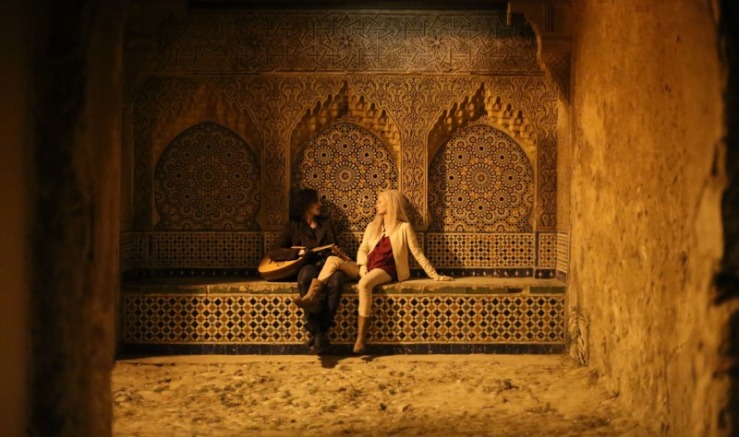
But Only Lovers is not Jim Jarmusch telling those damn kids to get off his lawn, nor is it the rantings of a snob. A more compelling take is offered at The Pinocchio Effect, where, commenting on the whiteness of Only Lovers, the author suggests:
…the film becomes an allegory of the dead end of white Euro-American culture, which can only live so long upon its no-longer-active cultural heritage of Elizabethan poetry and vinyl 45s.
Eve buys Adam an oud. Will his new music be a form of vampirism, sucking life-spirit from Moroccan culture? It’s worth noting here that the guitarist in the cafe who reinvigorates Adam plays a Fender guitar. Perhaps Jarmusch offers a gesture toward cross-cultural synthesis. Maybe we could even entertain the idea that our vampires are “sharing” immortality with the Moroccan couple they attack. But that seems like a huge maybe.
Ultimately, Only Lovers Left Alive stands on its own aesthetic merits. It couples an awareness of its own blind spots with a deep faith in its creation/curation of beauty. Highly recommended.
Trailer:

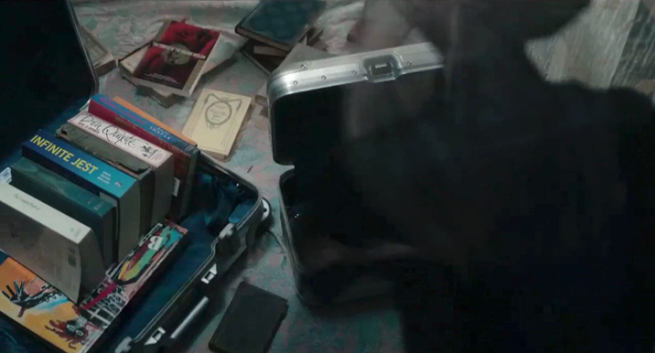
I haven’t watched it yet, but your review made me want to see it even more.
LikeLike
Reblogged this on modalalien.
LikeLike
“she scrolls her fingers through pages briskly but lovingly, seeming to absorb each one instantly.” I had the same understanding when I saw that part. And yet I was confused later on we see her read on the plane. The Voice Over and the time she spends on one page suggests she reads like a mortal after all.
LikeLike
I think she can read the print like hyperbraille or something…like she feels the text and instantly recalls each page—but she can also spend time meditating over a single phrase/page.
The vampire powers weren’t exactly clear. In the scene at the bar (White Hills show) they can move really fast, but later they struggle moving the body (and also seem to huff and puff).
LikeLike
Ah! All throughout the film the conventions of the vampire genre–so overdone and abused as of late (Twilight, True Blood)–are complicated. I agree with your observations.
I’m not too keen on Adam’s style / genre of music — the textural, guitar distortion pieces — but he kept referring to them as “funereal” pieces. What are your thoughts on that? Was I actually hearing “funereal” music? Sounded like noise-rock to me.
LikeLike
I think they have a doom rock minor key dark march stomp pensive sad ominous feel to them…which if Adam says is funeral music I agree. They definitely feel like dirges.
LikeLike
I’ve seen commentary on Only Lovers that characterizes the leads as hipsters or just plain snobs, but I thought Jarmusch addressed the snob criticism well in an interview (http://goo.gl/eI7265), saying: “Well, if you and I were alive for 500, 1,000, 2,000 years, we would certainly appear as snobs to everyone else, because our knowledge and experience would be so much more vast, you know?”
Sure, Adam and Eve are the essence of cultured curators and creators, but I found the environmental commentary and love story even more interesting and sweetly subtle. Adam’s “zombie”-induced depression is a feeling I have every time I think about the state of the West Antarctic ice sheet. Us “zombies” ruined the world and the fictitious vampires of Only Lovers have to deal with the curse of a relative immortality that hinges on their food source not destroying the planet and themselves, the unfortunate and likely outcome of our self-destructive tendencies. Adam can only lament the dismissal of the world’s greatest scientific minds by the stupid politics of humanity while Eve lovingly counterbalances his pessimism with her perspective and optimism as a survivor of even more cataclysmic episodes than her centuries-younger husband.
You nailed it with your opening line. The Only Lovers Left Alive *is* excellent, and arguably Jim Jarmusch’s finest work to date (including Dead Man). The slow pacing was a welcome departure from the popcorn movies of late, and I thought of my experience of watching 12 Years a Slave as the scenes continued past when I would have expected a cut, especially the musical ones. My only quibbles align with yours in that the film could have used more time in Tangier to balance the careful study of decaying Detroit from the bulk of the movie.
LikeLike
I wanted to write about the environmental commentary more, but I was already shoehorning too much into this piece. I went home and watched Dead Man after OLLA—not sure exactly how, but they are of a piece (along with Ghost Dog, the twin of Dead Man).
I’ve seen a lot of commenters on the film seem to mistake Adam’s viewpoint for the film’s viewpoint. His negativity is seductive, to be sure, but Eve, as you point out, offers a more mature, balanced perspective.
I think that it might be JJ’s best…or at least one of his best.
And the snob thing…I don’t even know where to begin. There’s a real populist streak there, I think, to that criticism, which is aesthetically bound to a culture where “artists” rely on ready-mades, installation art that requires context, autotune, gimmicks, etc.—that our culture assesses these shortcuts “equally” against artists and curators who have a deep and real full knowledge, appreciation and *skill* in/for their art.
LikeLike
It’s one of Jarmusch’s best, I completely agree. There are so many themes in OLLA, yet it doesn’t seem overburdened by them. Ideas about the true nature of love, environmentalism, fame, creation and curation, all fit nicely together under Jarmusch’s writing and direction.
OLLA is a welcome return to subtlety after his flirtation with downright opaqueness in his last feature, The Limits of Control. That isn’t to say I didn’t enjoy TLoC, but I think there’s something frustrating about a movie that is so outside the traditional narrative that it’s virtually impossible to boil down into a summary for someone you’re trying to convince to watch it!
I have to wonder how much of Eve’s perspective is from Jarmusch himself, who spent time in the heyday of the NY art scene and is now in his 60s.
LikeLike
Dead Man is, thus far (for me at least), his most intelligently wrought work (though you guys are doing a terrific job of selling me on OLLA). It’s rhyming scheme, Neil Young’s haunting, elliptical score, and the movie’s careful winks of subtextual humor (all those ostensibly cliched wise-Indian aphorisms that are, in fact, William Blake poem quotes) — all those things have come together to make that one of the greatest, most inspiring movie experiences I’ve ever had. Have either of you two–Edwin (is it?) and/or Damon–read Jonathan Rosenbaum’s book on Dead Man? Edwin: From what I remember reading Rosenbaum’s piece, he also thinks that Ghost Dog and Dead Man are twins.
LikeLike
[…] Only Lovers Left Alive […]
LikeLike
Love this review. Insightful and poetic.
LikeLike
Thanks.
LikeLike